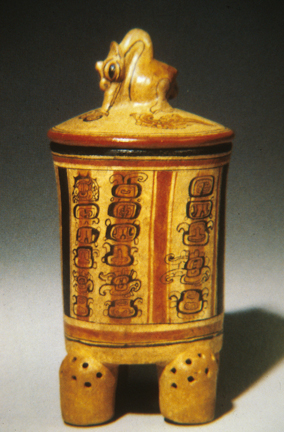The Classic Period (250-900 CE) witnessed the rise of Mesoamerica's most accomplished civilization, the Maya. This culture was located in what is now the state of Yucatán in Mexico, and the neighboring areas of modern day Guatemala, Belize, and Honduras. The Mayan culture developed mostly in isolation and was relatively secure from outside invasion. Their achievements in astronomy, mathematics, writing, art and architecture were unrivaled in Mesoamerica and perhaps in the world. Influenced by the art and culture of Teotihuacán and the even earlier Olmecs, the Maya took the artistic traditions of these precursor cultures and reached greater heights.
This example is from the early Classic, and is one of the earliest vessels to be painted with hieroglyphic text. Until relatively recently some thought that these hieroglyphics were not true writing, but were merely decorative. It was the linguist Michael Coe who succeeded in deciphering this writing system, and this process is detailed in his work, 'Breaking the Maya Code,' published in 1992. The text on this piece is painted in 6 vertical columns, and represent the day signs of the Mayan calendar. Note the exquisite use of calligraphic line in writing these characters. The Mayan calendar is based on what was called the 'Long Count,' and begins with the date, August 13, 3114 BCE. It is based on an interlocking system of a 260 day lunar cycle and a 365 day solar cycle, so accurate that a better calendar was not developed until the 20th century. Mayan ceremonial centers usually included an observatory, and these domed structures are strikingly similar to modern observatories in their designs.
This burnished tetrapod (4 legged) lidded vessel has hollow legs that contain small balls of clay so that the entire piece would rattle when shaken, and bears a bird figure on the lid as a handle. The Mayan artist typically used only 4 slip colors, black, red, buff, and white. All the colors except white are seen on this elegant example. Note also that the shape is quite reminiscent of the tripod vessels made at Teotihuacán.

Mayan polychrome tetrapod lidded jar from Tikal, Earthenware
Early Classic period, 357-495 CE


